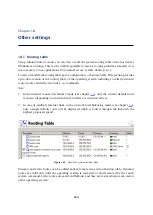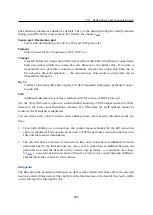
18.1 Routing table
225
Note:
Changes in the routing table might interrupt the connection between the
WinRoute Fire-
wall Engine
and the
Administration Console
. We recommend to check the routing table thor-
oughly before clicking the
Apply
button!
Route Types
The following route types are used in the
WinRoute
routing table:
•
System routes
— routes downloaded from the operating system’s routing table (includ-
ing so called persistent routes). These routes cannot be edited some of them can be
removed — see the
Removing routes from the Routing Table
section).
•
Static routes
— manually defined routes managed by
WinRoute
(see below). These
routes can be added, modified and/or removed.
The checking boxes can be used to disable routes temporarily —such routes are pro-
vided in the list of inactive routes. Static routes are marked with an
S
icon.
•
VPN routes
— routes to VPN clients and to networks at remote endpoints of VPN tun-
nels (for details, see chapter
). These routes are created and removed dynamically
upon connecting and disconnecting of VPN clients or upon creating and removing of
VPN tunnels. VPN routes cannot be created, modified nor removed by hand.
•
Inactive routes
— routes which are currently inactive are showed in a separate section.
These can be static routes that are temporarily disabled, static routes via an interfaces
which has been disconnected or removed from the system, etc.
Static routes
WinRoute
includes a special system for creation and management of static routes in the routing
table. All static routes defined in
WinRoute
are saved into the configuration file and upon each
startup of the
WinRoute Firewall Engine
they are added to the system routing table. In addition
to this, these routes are monitored and managed all the time
WinRoute
is running. This means
that whenever any of these routes is removed by the
route
command, it is automatically
added again.
Note:
1.
The operating system’s persistent routes are not used for implementation of static routes
(for management of these routes,
WinRoute
uses a proprietary method).
2.
If a static connection uses a dial-up, any UDP or TCP packet with the
SYN
flag dials the
line. For detailed information, see chapter
Definitions of Dynamic and Static Rules
Click on the
Add
(or
Edit
when a particular route is selected) button to display a dialog for
route definition.
Summary of Contents for KERIO WINROUTE FIREWALL 6
Page 1: ...Kerio WinRoute Firewall 6 Administrator s Guide Kerio Technologies s r o...
Page 157: ...12 3 Content Rating System Kerio Web Filter 157 Figure 12 7 Kerio Web Filter rule...
Page 247: ...19 4 Alerts 247 Figure 19 14 Details of a selected event...
Page 330: ...Chapter 23 Kerio VPN 330 Figure 23 55 The Paris filial office VPN server configuration...
Page 368: ...368...
















































